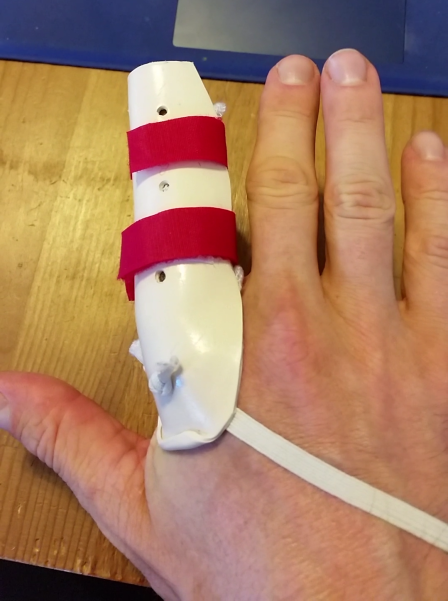or
On How I Continued Strength Training with a Broken Finger
About a month ago I broke a finger. My right index finger, proximal phalanx. Yes, I'm right-handed.
I broke it sword-fighting. (For those who don't know I do Historical Fencing at
Athena School of Arms.) My opponent's sword hit a gap in my protective gear. The hit split my skin all the way down to the tendon. There was a visible, longitudinal defect in the tendon - that I got to see in the ER. And there is a diagonal fracture along the length the bone. Minor as far as fractures go - not displaced or open.
And so I was put into a heavy duty splint. It immobilized me from the tip of the index finger down to the carpal bones. With the middle finger included in the finger splint, almost like buddy taping the fingers. And it wrapped around the base of my thumb. I could barely get my thumb and pinky finger to grip.
But I Did Strength Training Anyways
I'm not convinced the OT who created my splint would have really approved of my exercise routine, but . . .
There was no chance I was going to stop unless it was impossible.
Lower Body Strength Training
Squats, and variants thereof, were alright, it was just harder to grip the bar solidly to stabilize it. I've just been concerned with the fail state - if I had to ditch the weight I can't move my hand out of the way as easily as usual.
Deadlifts are right out because I can't generate the grip strength necessary. So I replaced them with
barbell hip thrusts. It's possible to move a surprising amount of weight with this. I'm up to almost 300 pounds with this. Single-leg deadlifts were still doable because the weight was light enough to grip.
Upper Body Strength Training
This is where it got interesting. I couldn't do any pushing exercises because the splint came down across the heel of my palm by the thumb. And of course I had trouble gripping for pulling exercises!
I solved this with a lifting hook. This is like the more common lifting straps, but I went for something more intense, these:
Lifting Lab Weightlifting Hooks. These put almost all the pull into the strap around my wrist letting me do pulling exercises pretty close to normal. I even reached a point where I could do pullups!
The other workaround I used was to put an ankle strap around my wrist and use a cable column machine for flyes, reverse flyes and front raises. This allowed me to target both the pecs with the flyes and the deltoids with the raises. Thereby covering the same muscles I would work with typical pushing exercises. This preserves the muscle performance.
When I got back to bench press last week my plan had worked and I had maintained nearly 100% of what I was at when I broke my finger (5 pounds away from finally benching 2 plates!)
And the reverse flyes hit the mid-back muscles until I was able to return to doing rows instead.
Olympic Lifts
. . . were right out. Boo. But I continued with box jumps to keep up my lower body explosive power.
Progress
At my follow-up appointment last week the splint got reduced to just a finger splint, freeing up most of my hand and allowing me to go back to doing regular pushing exercises. Hooray!

After a few weeks like that and now I can even take the splint off and type normally.
The Physical Therapy Attitude
I didn't let my injury stop me anymore than absolutely necessary. I kept up with every exercise I could and adapted those that were not doable in the usual manner. A big part of what I see physical therapy as being good for is this concept of maintaining function and adapting instead of stopping activity. We keep people moving. No matter what (almost).
